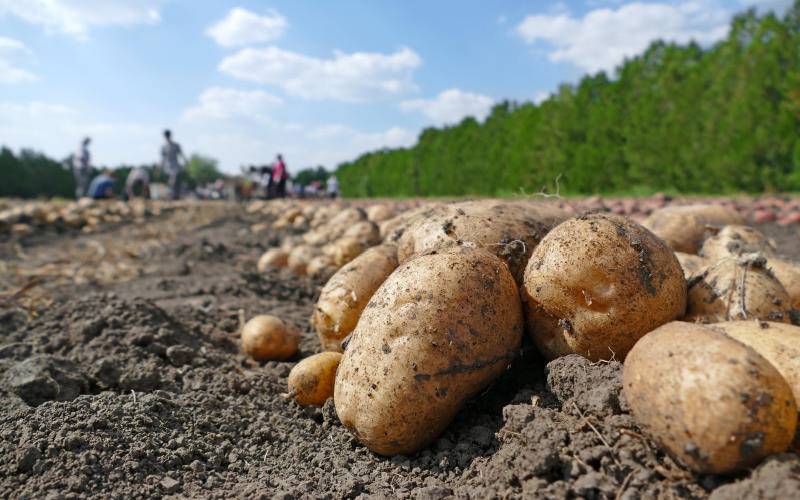
Potatoes are grown for their attractive market prices. However, this lucrative investment can result into frustration especially if diseases strike. The best way to guarantee success in production is to prevent them.
Late Blight
This is a lethal fungal disease that can wipe away your entire crop. The disease is especially damaging during cool and wet weather. The fungus can affect all plant parts. Infected crop have young lesions that are small and appear as dark, water-soaked spots. These leaf spots will quickly enlarge, and a white mould will appear at the margins of the affected area on the lower surface of the leaves. Complete defoliation can occur within 14 days or less from the first symptoms. Infected potato tubers have a dry, corky rot that may be brown or reddish. Tubers do not show symptoms of infection until storage time. The fungus produces a foul odour when infection is severe. The fungal spores are transmitted between plants by rain and wind.
Management
Always ensure plant leaves are dry through proper spacing. Also avoid overhead watering, especially late in the day. Plant certified disease free seeds and disease-resistant varieties. Rotate your potato with crops that are not in potato family such as beans. Remove and destroy diseased plants and tubers from the field. If the infestation is serious, consider chemical control. The following fungicides are recommended; chlorothalonil, copper fungicide or mancozeb.
Early Blight
Another fungal disease characterised by small, black lesions mostly on the older foliage. Spots enlarge and concentric rings form at the centre of the diseased area. Tissue surrounding the spots may turn yellow. The fungal spores remain on plant debris and on host plants such as eggplant, tomato and black nightshade. Bruised tubers during harvesting provide entry point for infection.
Management
Practice crop rotation, eradicate weeds, fertilise properly and keep the plants growing vigorously. Remove diseased plants immediately after harvest. Use disease-free seed. For chemical control, use mancozeb, chlorothalonil or copper fungicide.
Common Scab disease
It is caused by a bacteria and can remain in soil for a long period. Infected potato tubers have brown corky scabs or pits. These spots enlarge and merge together, sometimes covering the entire tuber. Leaves and stems are not affected. Scab is most severe in dry soil with a pH above 5.5, and in soil low in nutrients. Tubers infected with scab are edible, however, when blemishes are removed, much of the tuber is wasted.
Management
Ensure soil pH is between 5.0-5.2. Alkaline materials such as lime and wood ashes would raise soil pH making the soil conducive for disease attack. Scab thrives in low moisture conditions. To avoid this, keep the soil moist to stop infection. High levels of nitrogen and potassium increases scab severity. Do not use manure on potatoes, because the bacterial spores can pass intact through the digestive tracts of animals. Practice crop rotation.
Root-Knot Nematodes:
Stay informed. Subscribe to our newsletter
Nematodes are microscopic worms that live in the soil and feed on plant roots which causes stunting. Infestation is characterised by poor growth. The damaged roots cannot supply the required water and nutrients to the aboveground plant parts, and the plant is dies slowly. The root-knot nematode causes small inconspicuous root swellings or galls to develop.
Testing roots and soil is the only positive method for confirming the presence of nematodes. There are no chemicals available to control nematodes in planted soil. However, there are a number of approaches that can be applied to control the nematodes. Practice crop rotation integrating marigold which has the potential of reducing nematodes in the soil.
 The Standard Group Plc is a
multi-media organization with investments in media platforms spanning newspaper
print operations, television, radio broadcasting, digital and online services. The
Standard Group is recognized as a leading multi-media house in Kenya with a key
influence in matters of national and international interest.
The Standard Group Plc is a
multi-media organization with investments in media platforms spanning newspaper
print operations, television, radio broadcasting, digital and online services. The
Standard Group is recognized as a leading multi-media house in Kenya with a key
influence in matters of national and international interest.
 The Standard Group Plc is a
multi-media organization with investments in media platforms spanning newspaper
print operations, television, radio broadcasting, digital and online services. The
Standard Group is recognized as a leading multi-media house in Kenya with a key
influence in matters of national and international interest.
The Standard Group Plc is a
multi-media organization with investments in media platforms spanning newspaper
print operations, television, radio broadcasting, digital and online services. The
Standard Group is recognized as a leading multi-media house in Kenya with a key
influence in matters of national and international interest.


